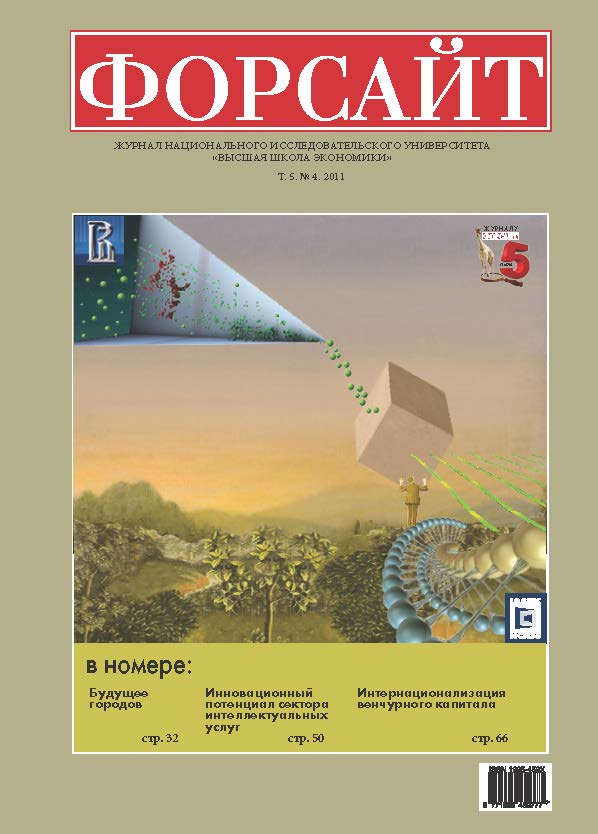Abstract
The paper reviews the work of the expert group “The transition from fostering innovation to innovation-based growth” on adjusting the Strategy for socio-economic development of Russia up to 2020. Panel experts have undertaken a detailed analysis of the state of the art of the Russian innovation sphere and proposed recommendations on the strategic priorities for state policy, as well as on specific regulatory tools that can be implemented in the near future.
Among the key challenges identified are the increasing Russian dependence on foreign markets, the growing socio-economic risks, the difficulties with adequately responding to the rapidly changing global trends, the significant gaps between the main actors of the innovation system, the lack of sufficient access to new technologies and innovations by different social groups.The most significant positive trends include: the introduction of new regulatory tools, the gradual expansion of the number of players in the innovation sector and the growth of public R&D funding.
The experts propose three possible scenarios, as follows: the inertial scenario, which implies low rates of economic growth while preserving the dependence of the economy on extractive industries; the progressive scenario, which presumes the accelerated integration into global processes and transition to the post-industrial model, and the moderate scenario, which has the highest probability of realization. The implementation of a scenario depends on political choices made by legislators, regulators, scientists and others. For example, in education there is a need to choose between “soft” adaptation of existing educational programs to meet the changing needs of the economy and greater emphasis on the development of specific professional skills.
The paper also formulates some directions for innovation policy. It focuses on support for innovative projects that meet tight technology priorities to those that foster mass innovation in all sectors of the economy. It differentiates priorities by sector in regard to various criteria: policy instruments, innovation in high- and low-tech sectors, decentralization, regional empowerment, institutional development, business partnerships; and network cooperation. It focuses on output-oriented decision making and balancing thematic and functional priorities to reduce failures in the innovation cycle. The authors emphasize the social effects of innovation policy. They discuss the need for supporting the creative class now existing as well as training future entrepreneurs, managers and professionals for the innovation sector and for the economy as a whole.
References
Global R&D Funding Forecast (2008)//R&D Magazine, December.
Dutta S. (ed.) The Global Innovation Index 2011. Fontainbleau: INSEAD.
European Commission (2009) Policy Mixes for R&D in Europe. UNU-MERIT.
European Commission (2010) Europe-2020: A Strategy for a Smart, Sustainable and Inclusive Growth. Brussels.
OECD (2000) A New Economy? The Changing Role of Innovation and Information Technology in Growth. Paris. P. 7-8.
OECD (2008) OECD Reviews of Innovation Policy. China. Paris.
OECD (2010a) The OECD Innovation Strategy. Getting A Head Start on Tomorrow. Paris.
OECD (2010b) The Innovation Policy Mix. STI Outlook 2010: Chapter 4. DSTI/STP (2010)12. Paris.
OECD (2011) OECD Reviews of Innovation Policy. Russian Federation. Paris.
Therrien P. (2010) R&D Tax Incentives and Government Forgone Tax Revenue: a Cross-Country Comparison. DSTI/EAS/STP/NESTI(2010)22 8-10 November 2010. Paris: OECD.
Апокин А.Ю., Белоусов Д.Р. (2009) Сценарии развития мировой и российской экономики как основа для научно-технологического прогнозирования // Форсайт. № 3(11). С. 12-29.
Гохберг Л.М. (2003) Национальная инновационная система России в условиях «новой экономики» // Вопросы экономики. №3. С. 26-44.
Гохберг Л.М., Заиченко С.А., Китова Г.А., Кузнецова Т.Е. (2011) Научная политика: глобальный контекст и российская практика. М.: НИУ ВШЭ.
Гохберг Л.М., Кузнецова И.А. (2009) Инновации в российской экономике: стагнация в преддверии кризиса? // Форсайт. № 3(11). С. 28-46.
Гохберг Л.М., Кузнецова Т.Е., Рудь В.А. (2010) Анализ инновационных режимов в российской экономике: методологические подходы и некоторые результаты // Форсайт. Т. 4. № 3. С. 18-30.
Инновационное развитие -основа модернизации экономики России (2008) Национальный доклад. М.: ИМЭМО РАН, ГУ-ВШЭ.
Мишарин А.С., Клепач А.Н., Белоусов Д.Р. (2011) Посткризисное развитие России: модернизация, инновации и социальное государство. Перспективы до 2025 года. Екатеринбург: ОАО «ИПП «Уральский рабочий».
Российский инновационный индекс (2011)/Под ред. Л.М. Гохберга. М.: НИУ ВШЭ.
Россия в цифрах 2010. Краткий статистический сборник. М.: Росстат.

This work is licensed under a Creative Commons Attribution 4.0 International License.

